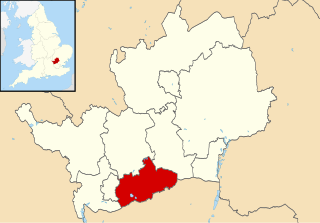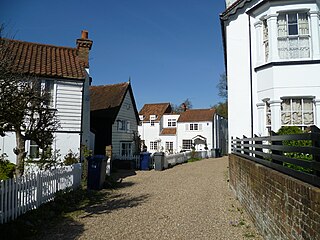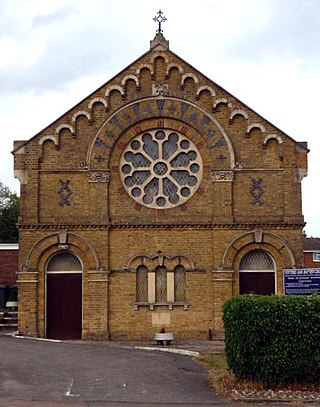
Middlesex is a historic county in southeast England. Its area is almost entirely within the wider urbanised area of London and mostly within the ceremonial county of Greater London, with small sections in neighbouring ceremonial counties. Three rivers provide most of the county's boundaries; the Thames in the south, the Lea to the east and the Colne to the west. A line of hills forms the northern boundary with Hertfordshire.

Enfield is a large town in North London, England, 10.1 miles (16.3 km) north of Charing Cross. It had a population of 156,858 in 2018. It includes the areas of Botany Bay, Brimsdown, Bulls Cross, Bullsmoor, Bush Hill Park, Clay Hill, Crews Hill, Enfield Highway, Enfield Lock, Enfield Town, Enfield Wash, Forty Hill, Freezywater, Gordon Hill, Grange Park, Hadley Wood, Ponders End, and World's End.

Potters Bar is a town in Hertfordshire, England, 13 miles (21 km) north of central London. In 2011, it had a population of 21,882. In 2022 the population was around 23,325.

Chipping Barnet or High Barnet is a suburban market town in north London, forming part of the London Borough of Barnet, England. It is a suburban development built around a 12th-century settlement, and is located 10+1⁄2 miles (17 km) north-northwest of Charing Cross, 3 miles (4.8 km) east from Borehamwood, 5.2 miles (8.4 km) west from Enfield and 3.2 miles (5.1 km) south from Potters Bar. Its population, including its localities East Barnet, New Barnet, Hadley Wood, Monken Hadley, Cockfosters and Arkley, was 47,359 in 2011.

Hertsmere is a local government district and borough in Hertfordshire, England. Its council is based in Borehamwood. Other settlements in the borough include Bushey, Elstree, Radlett and Potters Bar. The borough borders the three north London boroughs of Harrow, Barnet and Enfield, and is located mainly within the M25 Motorway.
The EN postcode area, also known as the Enfield postcode area, is a group of eleven postcode districts in England, within seven post towns. These cover parts of northern Greater London, southern Hertfordshire and western Essex.

Barnet was a local government district in south Hertfordshire from 1863 to 1965 around the town of Barnet.

East Barnet Valley was a local government district from 1863 to 1965 around the town of East Barnet. It was partly in the counties of Hertfordshire and Middlesex until 1889, when the Middlesex part was transferred to Hertfordshire. It was renamed East Barnet in 1935.

Potters Bar Urban District was a local government district in England from 1894 to 1974, covering the town of Potters Bar and the village of South Mimms. The district was initially called the South Mimms Rural District, being renamed in 1934.

Monken Hadley is a place in the London Borough of Barnet. An ancient country village north of Barnet, it is now a suburban development on the very edge of Greater London 11 miles (18 km) north north-west of Charing Cross, while retaining much of its rural character.

Wrotham Park is a neo-Palladian English country house in the parish of South Mimms, Hertfordshire. It lies south of the town of Potters Bar, 17 miles (27 km) from Hyde Park Corner in central London. The house was designed by Isaac Ware in 1754 for Admiral John Byng, the fourth son of Admiral George Byng, 1st Viscount Torrington, and remains in the family at the heart of a 2,500-acre (10 km2) estate. It is one of the largest private houses near London inside the M25 motorway. Its distinctive exterior has been used over 60 times as a filming location.

South Hertfordshire was a constituency in Hertfordshire which returned one Member of Parliament (MP) to the House of Commons of the Parliament of the United Kingdom. It was created for the February 1974 general election and abolished for the 1983 general election when it was mainly replaced by the new Hertsmere constituency.

Enfield was a constituency for the House of Commons of the UK Parliament from 1885 until 1950. The area sloping to the River Lea in the east was in the far north of Middlesex centred on the town of Enfield. The area formed part of the London conurbation and was much reduced over the course of its existence, in 1918 and then insignificantly in 1945 due to suburbanisation and urbanisation. It returned one Member of Parliament (MP).

St Ann's Church, South Tottenham, is an Evangelical Anglican church in the St Ann's neighbourhood in South Tottenham, London, UK, a part of the Church of England. The church currently holds one Sunday service at 10.30am.
The History of local government districts in Middlesex outside the metropolitan area began in 1835 with the formation of poor law unions. This was followed by the creation of various forms of local government body to administer the rapidly growing towns of the area. By 1934 until its abolition in 1965, the entire county was divided into urban districts or municipal boroughs.
St Ann's is a neighbourhood in Tottenham, north London, England, in the London Borough of Haringey. It is located to the east of Harringay and West Green and is within, but distinct from, St Ann's ward.

Frederick Charles Cass (1824-1896) was the rector of the parish of Monken Hadley in north London. His father, also Frederick Cass, owned the relevant advowson giving the right to make such appointments. He was the author of works of local history relating to South Mimms, Monken Hadley and East Barnet.

The Potters Bar Old Baptist Church, as it is now known, is a former church in Hertfordshire, England. It was designed by W. Allen Dixon in 1868. Dixon specialised in church architecture and Baptist churches in particular.

The Fox is a public house in Palmers Green, north London, on the corner of Green Lanes and Fox Lane. A Fox pub and hotel has stood on the site for over 300 years. In 2004, The Fox featured in the film of J.K. Rowling's novel Harry Potter and the Prisoner of Azkaban. In 2015, The Fox was the first Asset of Community Value to be registered in the London Borough of Enfield.


















